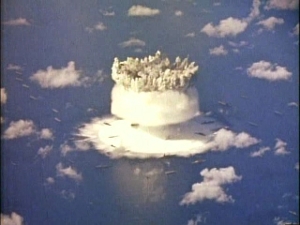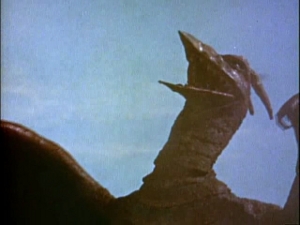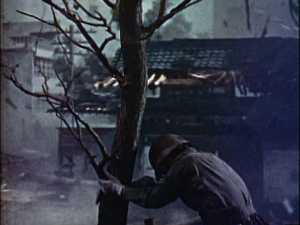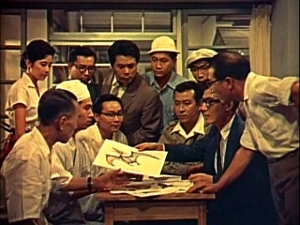
If you’re at all like me, you probably received Rodan for Christmas at some point in the early 1990s. You dutifully spent the rest of the day ignoring your family in favor of traveling back to the middle 1950s, when giant monsters roamed the Earth and Scientists were heroes. You may not remember a damn thing about this film, but I’ll bet you remember that Video Treasure’s box art. Even the back of the box reads like a memorable relic from another time, letting us know in no uncertain terms that,
“This is the original thriller that delighted monster fans for years, starring the legendary RODAN, disturbed from his prehistoric slumber to wreck havoc on civilization.”
If you’re like me, reading this is the equivalent of ringing your personal dinner bell. If you’re not like me…well, I’ve just given you a taste of how it was for me. Now let’s see how it is.
Rodan represents a number of firsts for Toho Co.: the first daikaiju movie filmed in color, the first to achieve wide, international release, and the first to make any amount of money off said release, finally proving the worldwide financial viability of Japanese giant monster movies. Until now, I’ve gotten away with reviewing the Japanese versions of Godzilla and Godzilla Raids Again, but I’d feel remiss doing that to Rodan. Despite its recent Classic Media re-release, the American version of this film is still by far the most common (and cheapest). It’s the one everyone remembers…if they remember this movie at all. Not that it isn’t memorable…but you know how nostalgia works, flattening and distorting everything it touches. Like a three hundred foot reptile casually flattening an orphanage. For example: I’d forgotten how the American version beings with not one, but two dueling narrators.

The first comes courtesy of Americanizing screenwriter David Duncan, who drones over stock footage of H-bomb tests, describing what we’re seeing for the slow-witted, the dense, and the impressionable children who’d go on to spend the next ten frickkin’ years merging this sequence and Sarah Conner’s dream from Terminator 2: Judgment Day into a sort of ubernightmare. Yes, Duncan’s is a stock speech full of moralizing platitudes and emotionally potent oversimplifications about the Horrors of Nuclear Bombs, but it’s one of the greatest examples of the form you’re likely to find, concluding with Our Humble Narrator’s obvious questions:
“But what have these tests done to Mother Earth? Can the human race continue to deliver these staggering blows without arousing a reaction? A counterattack? A horror still undreamed of? There are those in the Japanese Islands who believe that the horror has already been seen. What is the aftermath? This is the story of such an aftermath.”
Useless prologue concluded, Duncan hands the Narrator Hat off to Our true Hero, Shigeru (Kenji Sahara), safety engineer for the coal minds of his hometown, Kitamatsu. “Almost all of us who live here,” Shigeru informs us, “are dependent upon the mines for our livelihood. It was in our Kitamatsu minds that an unusual horror began, on a day that started much like any other day” save for “a feeling of uneasiness in the air.” The mining crew must’ve felt those nuclear bomb tests through the Force, as if millions of feet of stock footage cried out in terror and were suddenly silenced…
Mineshaft #8’s the proximate cause of this unease. Its gone too deeply, the floor is creeping, and as Shigeru’s monologue fades (finally!) we see him get an emergency call: a flash flood in shaft 8, trapping two men – Yoshi and Goro – below two meters of water. Since this is a small town, Goro happens to be Shigeru’s future brother-in-law. Since this is a monster movie, Goro’s nowhere to be found. The men find Yoshi easily enough, but he’s already dead. “More than killed,” Shigeru narrates, “he had been slaughtered like an animal. Even in death there was a look of horror on his face.” Not that we see any of this look, mind. Or any of Yoshi’s “ugly” wounds. They amount to the odd smear of grease and stage blood, which Kitamatsu’s doctors proceed to wash right off. Nine minutes in and already I’m afraid Rodan’s chosen to invert the traditional composition admonition. “Tell, don’t show,” seems the order of Rodan‘s day.

Before Shigeru’s monologuing can get on my last nerve, he steps outside to have some actual dialogue with Yoshi’s understandably-distraught wife, two equally-distraught fellow miners who’re sure Goro punched Yoshi’s ticket…and Goro’s distraught-to-the-point-of-a-nervous-breakdown sister, Kiyo (Yumi Shirakawa), who will be our Chick for the remainder of the pictire. Shigeru “knows” Goro would never have stooped to murder and, since this is a monster movie and he’s Our Hero, that means we do too.
The first fifteen minutes of Rodan do a good job of establishing this working class community, its ins and outs, and the sense of impending DOOM Shigeru talked about earlier. A much better job, in fact, than screenwriter Takeo Murata did the previous year, when he and Shigeaki Hidaka shoehorned a workplace drama into Godzilla Raids Again. Here, Murata and first-time kaiju scribe Takeshi Kimura’s script is a tighter, leaner animal than either Godzilla film. For the first time in kaiju eiga, we meet our main characters at once and (with a few exceptions) remain with them throughout the film. No more sudden cutaways to islanders or escaped prisoners. Just pre-industrial working stiffs and the “horror” modern, industrial industry’s brought down upon their heads…or woken up beneath their feet.
Turns out Shaft #8’s extraordinary depth uncovered a clutch of bus-sized, man-eating arthropods, caterpillars with lobster claws the official literature calls “Meganuron.” With the mine closed due to that whole “possible murder” thing, the Maganuron content themselves with eating three police men. When that proves insufficient, a Meganuron crawls out of the mine and heads straight for our main characters, breaking into Kiyo’s house minutes after Shigeru’s arrived to try and comfort her (i.e., get her the fuck out of Dodge before Yoshi’s wife decides to pull a Goro, as she’s already threatened). The Meganuron proves resistant to small arms and machine gun fire, obviously. Nevertheless, it retreats back into the mine with Shigeru and a contingent of troops (Military Porn!) in hot pursuit.

You can’t get much more working class than working in a coal mine (going down, down, down), and Takeshi Kimura was Toho’s undisputed champion of the Working Class Hero. A card-carrying Communist, he goes out of his way here to make Shigeru a true Action Hero, having him kill a Meganuron with a whole line of coal cars. It’s gratuitous badassery, but nesessary to the plot, since all gunfire really does is kick off a cave-in (something a safety engineer might’ve cautioned the military against, but whatever), trapping Our Hero amongst the insects.
Here, Rodan returns to the formula our director, Ishiro Honda, established with Godzilla, transposed from the sea into the air. That cave-in proves only the first in series of earthquakes, one of which spits Shigeru back up to the surface world. Beset by Movie Amnesia and the barbaric psychoanalytical practices of his time, Shigeru sinks into a state verging on catatonia, forcing Kiyo to comfort him (and shield him from the Shrink Brigade) just as he comforted her ten minutes ago. Parallelism!
It’s also a handy place to stick the two of them, since they’re usefulness to the plot is almost completely at an end. A series of UFO sightings follow close behind the earthquakes, culminating in attacks on airplanes of all stripes and that thing this movie loves so much: droning narration. “The entire Pacific area is alarmed by this super-sonic maniac that is attacking anything that flies.” Sonic blasts generated by the UFO’s passage annihilate Chinese villages. Air travel throughout Northeastern Asia’s suspended and “the” Air Force ordered to shoot any UFO on sight. “Hundreds of eyewitnesses have observed this fantastic object, but always at such high altitudes and incredible speeds as to make an accurate description impossible.”

Uh-huh. Right. So this thing’s flying all over the Pacific Rim…flying low enough to knock out whole towns with its errant sonic booms…yet the only people who manage to catch a snapshot of its wing…are friends of this film’s Scientist, Professor Kashiwagi (Akihiko Hirata). Now that our Working Class Hero’s curled himself up into a little ball (I wonder if there’s an Ikari or three in Shigeru’s family woodpile?) we might as well hear from Science. And who better to represent it than the actor who played Dr. Serizawa? Too bad that, as Scientists go, Kashiwagi’s not nearly as heroic a figure. Point of fact, he’s down there with that walrus-mustached fellow who gave Angilas his name in Godzilla Raids Again. Kashiwagi just shows up, gets no character development, and suddenly everyone defers to him. Because…damnit, he’s a Scientist! What else can he do but speculate on the monster’s origins?
Shigeru finally recovers from his Movie Amnesia, and his flashback is one of Rodan‘s stand-out sequences. Kiyo notices her songbird eggs are in the process of hatching. She hands the nest to Shigeru, and the sight of the eggs opens all the floodgates of his mind.
All praise is due to the screenwriters, editors, and our director for the way this film proceeds. It’s a series of Big Reveals, a monster movie layer cake. Until those lobster caterpillers show up it could be a murder mystery. (So long as we ignore the prologue.) It remains a Monster In A Cave Story (far more common in Japan, and thus deserving of capitalization) until the earthquake frees Rodan, when it finally settles into the daikaiju movie formula. Thing is, none of these narrative twists feel forced or grating. They’re all necessary components of this film’s overall success. We paid for a giant pteradactyl movie, it spends fifteen minutes with miners and Big Bugs to lull us into a false sense of security…before delivering the goods, courtesy of Eiji Tsuburaya.

No surprise, the UFO is actually a flying reptile, trapped in suspended animation since the Cretaceous Period (thanks, Professor). Awakened by H-bomb tests, it fed on the Meganurons (also prehistoric animals trapped in etc.), grew strong, and now terrorizes the skies. Plus, Shigeru has his memory back, allowing him to reclaim the Superfluous Narration Baton. Oh, Superfluous Narration, how I’ve…not missed you at all.
“How could prehistoric monsters stir from their long death, to move about upon the earth again?” A nice question, Shigeru immediately answers for us, destroying all tension. “The only answer to that could be that they never really died: they only slept. We had dug too deeply for our coal and awakened them to destroy us all.” Ph’nglui mglw’nafh Cthulhu R’lyeh wgah’nagl fhtagn to you too, buddy. That which is not dead can eternal lie.
Seriously though, it’s 1956. Not content with making monsters simple stand-ins for The Bomb, Rodan asks us to consider that Modernity Itself is unleashing ancient monsters onto an unprepared modern world, gifting them with powers and abilities far beyond those of mortal monsters (like the H-Man, or the Mushroom People). The power to level cities like the elemental forces that carved Japan out of the sea and beset its people for centuries before the United States (and our Bombs) even existed. That’s why modernity’s weapons, for all their power, are useless against the very monsters they set loose. Only natural forces, comparable to the monsters themselves, can truly end this carnage.
And boy howdy, this is some good carnage, one of the best “monster attacks a city sequences” in the history of cinema. Our intrepid humans (led by Our Scientist, of course) stumble upon Rodan’s lair just in time to catch the creature going out for a bite…and learn it’s got itself a mate to boot. Guess fifty-foot tall, subterranean eggs are thick as thieves in Kyushu. Taking wing, the Rodans are set upon by the JASDF, who succeed only in forcing the two down over a populated area. (Sesebo in this dub; Fukuoka in the original cut). JDSF artillery proves as impotent as the air force, the city’s destroyed, and the Rodans escape back to their cave.

They should teach this sequence in schools. Everything, from the costume to the billboards our model tanks roll past, is both obsessively detailed, wreathed in the smoke and debris from gale force winds kicked up by the Rodans’ wings and the model army’s barrage. Just enough is shown, and just enough is obscured, to lend the whole thing an air of verisimilitude Godzilla Raids Again lacked. Compare the two climactic bits of city destruction: one took place at night in the land of Grayscale, which you’d think would’ve helped disguise the film’s budgetary woes. Rodan‘s team staged this in full daylight, filmed it in color, and handicapped themselves by adding in a new effect – wiring stuntman Haruo (Gojira) Nakajima up to a what was probably the most uncomfortable harness in all existence. Yet they still pull it off, and pull it off well, recapturing the apocalyptic sense of despair unkillable, city-smashing monsters should inspire in every film they appear in.
Even the bad blue screen effects help in their own, special way, making me giggle. Only problem is, we’ve got a full ten minutes to go after that high water mark. There’s really nowhere else to go…except back to Kitamatsu, where the army’s prepared to assault Rodan’s home network of caves. Sure, it might set off Kitamatsu’s tourist trap of a volcano, but that’s okay. Just evacuate the town’s folk, pat them on the head and say, “Hey, if you want to let the giant flying reptiles breed, by all means, stick around.” And since they’re the only characters we really know or care about, Shigeru and Kiyo stick around too, if only to watch the climactic montage of military pornography from minimum safe distance.
It takes the long way ’round to get to this point, but Rodan avoids the aesthetic pit-traps Toho fell into the year before. There are no crazy tonal shifts between workplace comedy and daikaiju drama, no flaccid rehash of the original Godzilla‘s end. Benefits of a better script and the superior performances Honda pulled out of his cast. Kenji Sahara in particular finds himself having to carry the whole movie, his believably-horrified reactions giving we, the audience, our excuse to suspend disbelief in turn, and treat all this with the seriousness it deserves.

It’s a seriousness we’d see less and less of as Toho moved toward the 60s, beginning it’s stranger experiments with the daikaiju formula. Rodan is one of the first, and arguably the most successful, beginning with a human story rather than simply snatching one up in an unfolding monster movie narrative. When we first met Professor Yamane, his hot daughter Emiko, and her arm candy Ogata, (Godzilla’s Scientist, Chick and Working Class Hero, respectively) they were little more than convenient pairs of eyes through which we could see the plot unfold. Here, we meet Shigeru and Kiyo right off, spend the first chunk of movie getting to know them, and by the half hour mark we’re invested. These two have a stake in the monster movie right away. Shame we have to leave them just as they’re hometown’s wiped out by a missile barrage/volcanic eruption.
Still…things could be worse…but before we get to that, we find Rodan standing out as one of the last painlessly-serious monster movies in Toho’s oeuvre. As such, it deserves our serious consideration. I’d go so far as to call it the last seriously good daikaiju film of the 1950s. Because honestly, fuck Varan.
![]()
![]()
![]()
![]()

The giant bugs freaked me out when I saw this as a kid. I’d already seen Monster Zero so I knew who Rodan was. I knew nothing about the man eating bugs. Those costumes look fake to me as an adult but as a kid they were as real as anything else in the movie. More real actually since the bugs were obviously in the same sets as the humans.
That’s one of the best things about Rodan – it brings “the horror” of it all down to human scale in a way Godzilla never did before (and wouldn’t do again until the 1980s). It’s one of the hardest things to do in a daikaiju picture and, consequently, creatives have a bad habit of either not bothering at all, destroying any chance for actual drama (Godzilla’s Heisei adventures are particularly bad about this – lots of standing around at Minimum Safe Distance for G-Force – good thing they’re such an intrepid, international, military unit, specifically trained to fight monsters) or following in King Kong‘s size-155 footprints. The Meganuron (or “Maganulon” if you want to be phonetic about it), straight Them! rip-offs though they may be, become one of the most versatile tools in Rodan’s box, bridging the gap between giant reptile and puny human in a way bluescreen and forced-perspective shots would take years to match, and I seriously doubt its ever been equaled…for now, at the very least.
I also was intrigued by the giant bugs in the beginning. Were they giant ticks? Also do you know where I can obtain the original version of Rodan. I only know of the Americanized version. I do have Gojira in my collection (which I love). Actually I cannot stand the Raymond Burr version as there is so much omitted. But I would really enjoy seeing and having the original version of Rodan.
Unfortunately, the only legal way to see the Rodan people saw when it first hit theaters is to import it for twice to three times the price of the dubbed version. And thanks to the magic of international copyright law (one of my several arch nemeses) you’ll also need to import a DVD /Blu Ray player. Honestly, the amount of hoops you have to jump through have always been, and continue to be, asinine and stupid. The execs at Toho might as well keep a giant money bonfire burning in perpetuity. There was a time when I hoped the Criterion release of Original Gojira would knock some sense into their heads, but then they let Gareth Edwards’ Gojira have the 60th anniversary all to itself.
Loved the “candiru” caption! Funniest thing I’ve seen in months. Thanks for a belly laugh that had my cube neighbors wondering what I was up to.
Glad to hear it! Nothing makes me happier than finding out these things had their intended effect. And in the words of that immortal bard, Samuel J. Snodgrass, as he was about to be lead to the guillotine, “Make ’em laugh, make ’em laugh…”
The Americanised version, although about ten minutes shorter, isn’t the usual hack job; besides restoring censored closeups of Rodan eating the big bugs (and removing a clumsy bit of business involving a not-at-all “surprising” reveal that there are TWO Rodans), The American version adds that narration at the end about how the second Rodan chooses to die with it’s mate rather than just abandon it… which I’ve always found strangely touching.
“Touching,” hell. Shigeru’s ending monologue reduced five-year-old me to tears the first time he heard it. The juxtaposition of our Working Class Hero’s empathetic understanding with the fiery, flaming doom on screen was far too much for a child raised on American cartoons, where no one dies – or, at best, die off screen. The Rodans’ death is probably the most graphic of its era, with the possible exception of Anguiras’ death in Godzilla Raids Again. And at least he died in an fair-ish fight with a physical equal. The Rodans went out like a pair of sacrifices from the Temple of Doom.
I agree with you wholeheartedly. The ending was graphic and also ahead of the time.